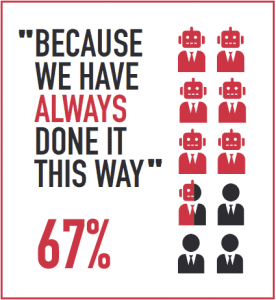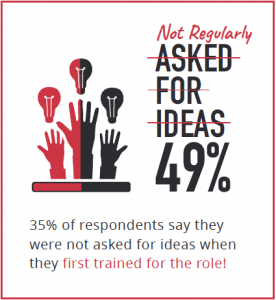How to Overcome FOSU (Fear of Speaking Up) and Share Your Ideas
 You want to share your great ideas to improve the business, but if you’re like many employees we work with, sometimes it’s hard to know just how or when to share them.
You want to share your great ideas to improve the business, but if you’re like many employees we work with, sometimes it’s hard to know just how or when to share them.
Maybe you’ve had a bad experience before and it feels safer to stay silent.
Or, perhaps you’re not quite sure if your idea is a good idea. But what it if IS a great idea, and you don’t share it?
If you’re not feeling confident about speaking up, you’re not alone.
In our research for Courageous Cultures, 40% of respondents said they lack the confidence to share their ideas.
67% said their managers operates around the notion of “this is the way we’ve always done it.
 And 50% said they worry nothing will happen to their ideas anyway– so why bother?
And 50% said they worry nothing will happen to their ideas anyway– so why bother?
And yet, during this challenging time of fast pivots, hybrid teams, and return to the office, your voice matters more than ever!
Can you imagine how much better things could be if we all came to work with one important question on our minds, “How can we make things better?” And then shared those creative ideas and did something about them?
If you haven’t already done this – download our I.D.E.A. Incubator Guide. It’s your free guide to a power-packed team innovation session that will mobilize courage and increase team engagement.
5 Important Steps to Share Your Ideas So They’re More Likely to Be Heard
We don’t want either of these reasons to prevent you from sharing your good ideas, so we’ve put together these practical steps to make it a bit easier.
1. Navigate the Narrative: Understand how past experiences may be creating FOSU (Fear of Speaking Up).
In Courageous Cultures terms, we call this “Navigating the Narrative.”
It’s human nature to remember a negative experience you had speaking up more than a positive one. This means an important step in gaining the confidence to speak up is to remember the times that you did speak up and it made a difference.
Think back on your career. What would you describe as your biggest moments of courage? Can you recall a time that you spoke up, even when you were nervous, challenged a decision, or shared an idea and it made all the difference?
P.S. We would love to hear about your biggest moments of courage in the comments below (e.g. I stopped a bully, I confronted my boss. I challenged the data.)
Courage breeds more courage, both in ourselves and with others.
2. Create Clarity: Ensure you understand the strategic priorities.
Most of the time when leaders tell us that their team is not that strategic, or express concern that they’re getting too many ideas they can’t use, the biggest issue is a lack of clarity about what matters most.
Yes, it’s your boss’s job to translate strategic priorities and to help you understand how you can add the most value … including what problems they’re looking to solve and where they need a great idea.
However, we all know that no manager is perfect, and sometimes this communication breaks down.
If you’re unsure of the strategic priorities, ask your manager with an approach like this.
I really care about this company and the success of our team.
I have some ideas I want to share that could help us to improve, but I want to ensure they’re on point.
What are some of the biggest challenges you’re working on right now? Are you open to some of my ideas in that arena?

3. Cultivate Curiosity
One surprising part of our courageous cultures research was that 49% of the respondents (across all levels of the business), said that they are not regularly asked for their ideas.
And, the sad truth is that many managers think they ARE asking because they have an open door. Which is great, but not enough.
We’re working hard on spreading the word on the importance of asking well.
In the meantime, our hope for you is that you won’t wait to be asked.
We want to ensure your voice is heard and that your feel confident to share your ideas.
Ask yourself and others a good courageous question.
If you want to cultivate curiosity about how to make things better, the easiest way to start is by asking courageous questions of yourself and others.
A courageous question differs from a generic “How can we improve?” question in that it’s both specific and vulnerable.
It’s specific in that the focus is narrow, you’re just thinking and talking about one area to improve. And it’s vulnerable because it assumes that improvement is possible.
For example:
- “What’s one thing we do that really frustrates our customers (and what can we do about it)?”
- “What’s one thing that’s sabotaging our productivity right now (and what should we do instead)?”
- “If we could make one change to improve the quality of our remote meetings, what would that be (and how can we make that happen)?”
One easy technique we teach leaders in our strategic leadership and fishbowl programs is called Own the U.G.L.Y.
You don’t have to be the one in charge to run people through these strategic questions. You can learn more about this process by downloading our free Idea Incubator Guide.
Own the U.G.L.Y.
U- What are we Underestimating?
G- What’s got to Go?
L- Where are We Losing?
Y- Where are we missing the Yes?
4. Share Your I.D.E.A.s
Sometimes when a good idea goes unnoticed, it’s just a matter of positioning.
To ensure your voice is heard, and help your ideas attract the attention they deserve, use our I.D.E.A. model to position them.
 I-Interesting
I-Interesting
Why is this idea interesting? What strategic problem does it solve? How will results improve from this idea (e.g. customer experience, employee retention, efficiency)?
D- Doable
Is this idea something we could actually do? How would we make it happen? What would make it easier or more difficult?
E- Engaging
Who would we need to engage to make this happen? Why should they support it? Where are we most likely to meet resistance?
A- Actions
What are the most important actions needed to try this? How would we start?
5. Respond with Regard
Of course, one of the best ways to ensure your voice is heard is to actively listen to the ideas of others.
When a coworker, project team member, or even your boss shares an idea, how you respond makes all the difference in their willingness to keep speaking up, and of course, will impact how they respond to your ideas.
If you want a team culture where everyone comes to work asking “How can we make this better?”, getting good at responding with regard to ideas (even if they are half-baked or off-base) makes all the difference.
Start Here to Ensure Your Voice is Heard
We want to ensure your voice is heard, so we’ve shared a lot here to give you some options to consider as you consider and share your ideas.
The most important part is to start.
Ask yourself, “How can we make things better around here?” Think about (and share) one I.D.E.A. that would help.
And then, ask your co-workers the same question and ensure their voice is heard too.
Want more tools and ideas like this to build a Courageous Culture?
First, download your free copy of the Let’s Grow Leaders I.D.E.A. Incubator Guide. Then, watch this video about our book – your roadmap to a Courageous Culture.








This was very inspirational, thank you. Until recently, I was always the one to speak up and offer improvements or challenge unsound decisions. But over the past months, none of my ideas seem to be heard and sometimes are actively ignored. Which is rather discouraging. However, I do know that I owe it to my team to keep fighting for them, so I will definitely make use of the advice in your post.
Thanks, Marta. I’m sorry you’ve been having some discouraging conversations. I’ll be interested to hear how it goes when you try the I.D.E.A. model. Thanks for all you do to encourage courage and support your team.